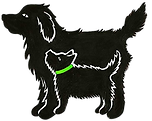Dogs and grass seed - what you need to know
- Pamela
- Jun 11, 2018
- 3 min read

How can something that sounds so innocent create so much harm?
Grass seeds are a common problem during the summer months. Grass seeds are small, sharp, pointy shaped like an arrowhead and can easily get brushed onto your dog as he moves, runs and bounds through grasses, the grass seeds attach to their coat and can burrow into the skin. They are designed to go forwards and not backwards, which is why you need to consult your vet if a grass seed becomes embedded in your dog’s skin.
You need to check your dog every time you come back from a walk particularly when you’ve been walking through grassy areas, across fields, through meadows or woodland.
Areas to check
Feet – check between your dog’s toes as the skin is more delicate here, you may not be able to see them, but if you gently feel between your dog’s toes with your finger you should feel what you may not be able to see. Check between your dogs underpads too. If it is safe to do so and has not entered your dogs skin, gently remove the grass seed to prevent it from burrowing into your dog to cause pain.
Ears – The grass seed can work its way through the fur around the ear and fall inside the ear. Once inside the ear you will need a vet to remove it safely, do not put anything in the ear as you don’t want to damage the ear canal or ear drum.
Eyes – Check the corners of the eyes, you may see grass seeds on the outside of the eye, wipe them away with a damp cloth. Gently pull the eyelids up and down to look inside the eye, if you see grass seeds sitting here use a damp cloth and gently wipe them outwards away from the eye. If in any doubt seek your vets advice.
Body – Grass seeds may stick in to your dogs coat, regular brushing should hopefully ensure that these are regularly removed from their coat preventing them from burrowing into the skin. Again, if it is safe to do so and the grass seed has not entered your dog’s skin, gently remove the grass seed to prevent it from burrowing into your dog to cause pain.
Symptoms
Your dog may become lame, licking or biting his paws making them sore. You may notice a painful swelling where your dog has licked an area, particularly his paws.
He may shake his head vigorously, scratch his ears or hold his head to the side.
His eyes may become swollen or you notice a watery discharge from the eye.
If your dog suddenly starts sneezing, rubbing his face or you notice a bloody nasal discharge it may be that a grass seed has gone up his nose.
If you see any of these signs check for grass seeds. If one has embedded itself in your dog’s skin, gone into his ear, eye or up his nose seek your vets advice.
Once a grass seed has entered your dog it can be very difficult to find, and they can travel a long way through the body from the entry site. Grass seeds don’t show up on an x-ray as they are vegetable matter and it is hard for the vet to know how big the problem maybe and surgery may be the only option.
Protecting your dog
Check over your dog when you come back from a walk.
Regularly brush your dog’s coat.
Keep the ear hair short to minimise the risk of grass seeds sticking to their fur and working their way into your dog’s ear.
Keep the hair on your dogs paws shorter during the summer months to make it easier to inspect and check your dog’s paws.
Keep the hair short under their groin and armpits, the skin in these areas is softer and more delicate.
Do not cut off a grass seed leaving part in your dogs body as this will make it even harder to detect.
If a grass seed has started to burrow into your dogs skin or you suspect your dog has a grass seed in his ear, eye or up his nose - CONSULT YOUR VET FOR ADVICE – the earlier a problem is detected the quicker it can be treated.
Hopefully we will have a grass seed free season but forewarned is forearmed.

























Comments